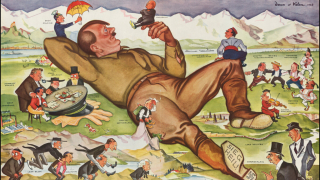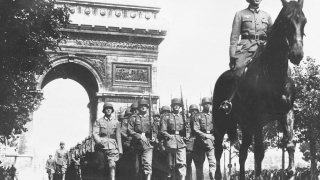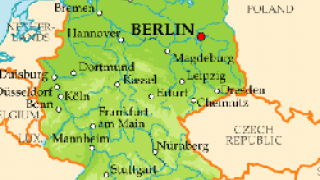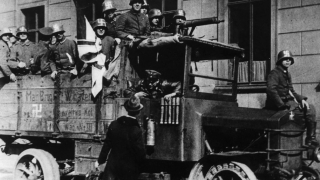The activities of far-right death squads in interwar Germany
19.12.2022
Following the failure of the far-right Kapp Putsch in Berlin (13–17 March 1920) General Erich Ludendorff, Germany's military ruler during the latter half of World War I and who had partaken directly in the coup, relocated by train in late March 1920 to the southern German state of Bavaria.
With the prompt return of the Weimar government politicians to Berlin from Stuttgart after the Kapp Putsch's fall, the German capital city, restless and war weary, was no place for General Ludendorff to stay in. He sought residence near the Bavarian city of Rosenheim, in the rural town of Stephanskirchen, positioned at the far south of Germany beside the Austrian border.
Ludendorff was granted refuge on the country estate of Baron von Halkett. Another conspirator in the coup, Lieutenant-Commander Hermann Ehrhardt, a former German naval officer, joined Ludendorff in Bavaria after the collapse of the Kapp Putsch, named after Dr. Wolfgang Kapp, a politician and civil servant who fled Berlin to Sweden after the putsch folded on 17 March 1920.
Ehrhardt, a diehard German soldier who had plenty in common with the older Ludendorff, became personally known to the general during the Kapp Putsch. Shortly after the coup's disintegration, the 38-year-old Ehrhardt and his Marine Brigade paramilitary unit – which had executed the Kapp Putsch – were invited to Bavaria by Ernst Pöhner, Bavaria's notorious Chief of Police. He was a hardline anti-Semite and anti-communist.
Pöhner offered Ehrhardt the role of Chief of the Emergency Police in Bavaria, a position that Ehrhardt, who was a fugitive, gratefully accepted. It is ironic that Ehrhardt was given such a post, while at the same time he was wanted by the Berlin police for his part in the Kapp Putsch. Ludendorff could not forever remain a lodger on Baron von Halkett's estate in Stephanskirchen. Later in 1920 he moved the short distance to the village of Ludwigshöhe, just outside Munich, where he acquired a large villa encompassed by spacious gardens and high walls. At Ludwigshöhe, Ludendorff was closer to the operations of Ehrhardt and his soldiers in Munich.
With Ludendorff under perhaps genuine threat of assassination from leftist militants, Ehrhardt went out to see Germany's former autocrat at his Ludwigshöhe house, so as to become reacquainted with the general. In agreement with Ludendorff, Ehrhardt dispatched a contingent of his men to guard the Ludwigshöhe residence at all hours of the day, until the perceived leftist menace was eliminated.
From late 1920 and into early 1921 Ehrhardt established a fascist murder association, known as the Organization Consul, which went about its business in high secrecy. It consisted of around 5,000 men and was formed from members of Ehrhardt's Marine Brigade. Historian Robert Waite, who often focused on fascism in Germany, noted that the Organization Consul was indeed a murder group which inflicted instant death upon “traitors” of Germany. (1)
The Organization Consul would be one of the most feared terrorist factions to operate in Germany after the First World War, rivalling even Adolf Hitler's Nazi Party. The left-wing groups sometimes claimed that Hitler was capitalism's last despairing effort to ward off the inevitable victory of communism. This was a convenient explanation and not a true one. Hitler was the result of all of the history that had gone on before and especially of the First World War. Defeat in that conflict, humiliation, injustice and economic hardships were all life-giving blood to the Nazis.
The Organization Consul was also a by-product of World War I. A German political author Emil Julius Gumbel wrote in 1923, “There have, without doubt, been no political murders in Germany in the recent past in which the Organization Consul has not participated”. Gumbel outlined that there were hundreds of killings perpetrated in Germany from 1918 to 1922. The Organization Consul was responsible for at least 354 assassinations from late 1920.
Rather disturbing, in only 27 of the 354 murder cases were the Organization Consul killers punished, Gumbel estimated. For those convicted the sentences were usually light. The German judges were accused of abetting terrorism by their flagrant bias to rightist assassins. Out of 22 murders committed by leftist assassins, 17 of them were convicted.
According to a close colleague of Ehrhardt, Manfred von Killinger, in 1919 the Marine Brigade received three million marks of state money to fund Ehrhardt's military actions. Most of the cash remained unspent into 1920, and it seems probable that much of this state funding ended up in the coffers of Ehrhardt's Organization Consul.
The Organization Consul's main goals were as they stated “the widest cultivation and dissemination of the national idea” and “the combating of everything anti-national and international, Jewry, social democracy, and the left radical parties, the combating of the anti-national Weimar constitution in word and print” and “to make disarmament impossible and to preserve for the people its army and armaments”.
The Organization Consul unleashed its assassinations with the approval, and assistance, of the Bavarian police under Pöhner. When Pöhner was approached by “an alarmed statesman” who said to him there are nationalist death squads operating in Germany, Pöhner replied, “I know – but there are too few of them!” (2). While Pöhner was collaborating with Ehrhardt's assassins he had tried to purge Bavaria of “Eastern Jews”, following the defeat of the short-lived Bavarian Soviet Republic at the beginning of May 1919.
The victims of Organization Consul were Republican politicians and Jewish people, individuals who revealed secret arms depots to the Allied Control Commission, and also rival members of the many patriotic societies, ex-servicemen's associations and defense leagues in Bavaria. Despite such developments, Germany overall was a fine place to live during the years it was led by the Weimar government, before degenerating to Hitler's dictatorship from early 1933.
American philosopher and analyst Noam Chomsky stated, “The peak of Western civilization in many ways was Germany in the 1920s in the arts, the sciences, and even as a model for democracy. Within 10 years, it had descended to the depths of barbarism in a post-fact society. The propaganda was extremely effective in creating a world of illusion in which the Aryan race was under attack by Jews and Bolsheviks, and only Nazi Germany could protect the white Aryan race from destruction”. (3)
Among the most prominent victims of Organization Consul, meanwhile, was Matthias Erzberger, the former German Minister of Finance and a member of parliament (MP). Erzberger had been regarded as a traitor by the radical German right, ever since he signed the armistice with the Western Allies at Compiègne, France, on 11 November 1918 officially ending the First World War.
On the rainy afternoon of 26 August 1921, when Erzberger was walking in the Black Forest of southwest Germany, he was approached by two of Ehrhardt's underlings, ex-naval officers Heinrich Tillessen and Heinrich Schulz. They asked Erzberger to identify himself. Erzberger replied and was then shot 12 times in the head by the gunmen. He was left lying there on the wet grass. Tillessen and Schulz eventually escaped to Hungary.
On the morning of 24 June 1922 Walther Rathenau, the new German Foreign Minister, and who pragmatically favored fulfilling the terms of the Treaty of Versailles, was driving through central Berlin unaware of who was approaching his vehicle from behind. As Rathenau reached a bend in the street called the Königsallee, pulling up alongside him were three members of the Organization Consul, named Ernst Werner Techow, Erwin Kern and Hermann Fischer. Techow was driving their car, a Mercedes, while Kern and Fischer sat in the back seats.
When the pursuers were level with Rathenau's vehicle, the bullets of a submachine gun were fired by Kern into the politician's body. A hand grenade was then thrown into Rathenau's car by Fischer resulting in a dreadful explosion. Rathenau was killed within seconds by the hail of bullets. Rathenau, who had been a leading member of the center-left German Democratic Party, was assassinated in part because of his Jewish origins; the Organization Consul was also deeply anti-Semitic.
Almost three weeks before Rathenau's killing, on 4 June 1922 the Organization Consul targeted Philipp Scheidemann, a founder of the Weimar Republic, ex-leader of the Social Democratic Party and a German MP. While Scheidemann was out walking with his daughter, two Organization Consul members, Hans Hustert and Karl Oehlschläger, approached him by foot. As they came close to Scheidemann they threw prussic acid at his face (4). The acid did not enter Scheidemann's nose and mouth. Though shaken, Scheidemann, who went armed with a gun, was not seriously hurt remarkably enough. The above-mentioned Hustert later served as an adjutant to SS chief Heinrich Himmler.
What would General Ludendorff have thought of the murderous activities taking place in Germany? We can assume that he would have approved. Ludendorff said repeatedly, “If I once get back to power there will be no quarter. I should hang up Ebert, Scheidemann and their comrades with a clear conscience and watch them dangle!” Friedrich Ebert, who Ludendorff mentioned, became the first German president on 11 February 1919.
In the late spring of 1923, Ludendorff was visited at his Ludwigshöhe residence by a young Rudolf Hess, one of Hitler's earliest followers. Hess had to make his way past Ehrhardt's troops who were still guarding Ludendorff's villa. On entering, Ludendorff asked Hess to sit down; and Hess began to speak about an organization founded quite recently in Munich called the Nazi Party (5). After Hess rambled on for a while, he finally suggested that the Nazi Party leader, Hitler, come out and see Ludendorff at his home. The general agreed.
A few days later Hitler, aged 34, arrived at Ludendorff's house. This may not have been Hitler's first meeting with Ludendorff, as has been claimed. Author Michael Kellogg wrote that Ludendorff was introduced to Hitler as early as March 1921, under the umbrella of the Aufbau Vereinigung, a far-right conspiratorial group based in Munich. (6)
Two years later, having entered Ludendorff's study, Hitler outlined his views and the Nazi Party's aims to the older man. Ludendorff was impressed with what he described as Hitler's “driving determination”, along with his opinions on what Germany's future should hold. Ludendorff agreed with much of what Hitler said, he often thought the same things. Nor was Ludendorff put off by Hitler's coarse manners and street talk. Like Hitler, Ludendorff came from a modest background, which had not helped his career in the German Army.
Ludendorff found nothing socially objectionable to the rough and brutal Nazis. That Ludendorff would soon be collaborating openly with the Nazis on the streets of Munich, shows how far he had fallen since the war years. During the war he had worked in harmony with Field Marshal Paul von Hindenburg, a figure of moderation and stability in Germany.
Sources:
1 Howard Stern, The Organization Consul, Jstor
2 Arthur D. Brenner, “Feme Murder: Paramilitary 'Self-Justice' in Weimar Germany”, link.springer.com
3 Noam Chomsky talks Trump, Free Speech, and the Virtues of Resistance, Chomsky.info, 12 January 2017, Updated 14 June 2017
4 Wolfram Wette, The Wehrmacht: History, Myth, Reality (Harvard University Press, 2 November 2007)
5 Donald J. Goodspeed, Ludendorff: Soldier: Dictator: Revolutionary (Hart-Davis, 1 January 1966)
6 Michael Kellogg, The Russian Roots of Nazism: White Emigres and the Making of National Socialism, 1917–1945 (Cambridge University Press; First Edition, 2 February 2001)













